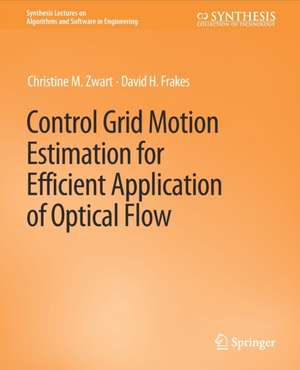Control Grid Motion Estimation for Efficient Application of Optical Flow: Synthesis Lectures on Algorithms and Software in Engineering
Autor Christine M. Zwart, David Frakesen Limba Engleză Paperback – 15 ian 2013
Din seria Synthesis Lectures on Algorithms and Software in Engineering
-
 Preț: 380.37 lei
Preț: 380.37 lei -
 Preț: 260.95 lei
Preț: 260.95 lei -
 Preț: 384.31 lei
Preț: 384.31 lei -
 Preț: 351.11 lei
Preț: 351.11 lei -
 Preț: 262.47 lei
Preț: 262.47 lei -
 Preț: 192.63 lei
Preț: 192.63 lei -
 Preț: 206.29 lei
Preț: 206.29 lei -
 Preț: 261.91 lei
Preț: 261.91 lei -
 Preț: 192.05 lei
Preț: 192.05 lei -
 Preț: 204.76 lei
Preț: 204.76 lei -
 Preț: 204.76 lei
Preț: 204.76 lei -
 Preț: 379.48 lei
Preț: 379.48 lei -
 Preț: 414.65 lei
Preț: 414.65 lei -
 Preț: 192.41 lei
Preț: 192.41 lei -
 Preț: 389.88 lei
Preț: 389.88 lei -
 Preț: 205.92 lei
Preț: 205.92 lei -
 Preț: 260.56 lei
Preț: 260.56 lei -
 Preț: 207.83 lei
Preț: 207.83 lei -
 Preț: 266.70 lei
Preț: 266.70 lei -
 Preț: 381.43 lei
Preț: 381.43 lei
Preț: 206.29 lei
Nou
Puncte Express: 309
Preț estimativ în valută:
39.48€ • 40.78$ • 32.86£
39.48€ • 40.78$ • 32.86£
Carte tipărită la comandă
Livrare economică 26 martie-09 aprilie
Preluare comenzi: 021 569.72.76
Specificații
ISBN-13: 9783031003929
ISBN-10: 3031003926
Ilustrații: VIII, 79 p.
Dimensiuni: 191 x 235 mm
Greutate: 0.17 kg
Editura: Springer International Publishing
Colecția Springer
Seria Synthesis Lectures on Algorithms and Software in Engineering
Locul publicării:Cham, Switzerland
ISBN-10: 3031003926
Ilustrații: VIII, 79 p.
Dimensiuni: 191 x 235 mm
Greutate: 0.17 kg
Editura: Springer International Publishing
Colecția Springer
Seria Synthesis Lectures on Algorithms and Software in Engineering
Locul publicării:Cham, Switzerland
Cuprins
Introduction.- Control Grid Interpolation (CGI).- Application of CGI to Registration Problems.- Application of CGI to Interpolation Problems.- Discussion and Conclusions.
Notă biografică
Christine M. Zwart received B.S.E. and M.S. degrees in bioengineering from Arizona State University where she is currently pursuing a Ph.D. in the same. She is a graduate researcher and doctoral candidate in the Image Processing Applications Lab working on image enlargement and enhancement algorithms with medical, defense, and consumer applications under the advisement of David H. Frakes. She is a National Science Foundation Graduate Research Fellow, a Science Foundation Arizona Graduate Research Fellow, a 2012 Arizona State University Faculty Women’s Association Outstanding Graduate Student, and was engineering intern at The Boeing Company. After graduating she plans to work in medical imaging informatics at the Mayo Clinic. David H. Frakes received B.S. and M.S. degrees in electrical engineering, an M.S. in mechanical engineering, and a Ph.D. degree in bioengineering, all from the Georgia Institute of Technology. In 2003, he co-founded 4-D Imaging, Inc., a small business that provides image and video processing solutions for the biomedical and military sectors. In 2008, he joined the faculty at Arizona State University (ASU) where he currently serves as a jointly appointed assistant professor in the School of Biological and Health Systems Engineering and the School of Electrical, Computer, and Energy Engineering. Professor Frakes was the ASU Centennial Professor of the Year in 2009, received the IEEE Outstanding University Faculty Award in 2011, and was awarded the National Science Foundation CAREER Award in 2012.He manages the Image Processing Applications Laboratory at ASU, which focuses on problems in image and video processing, machine vision, and fluid dynamics.
